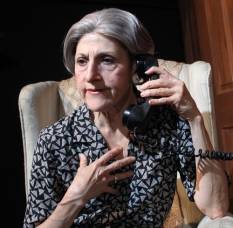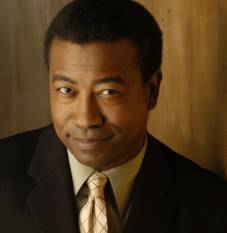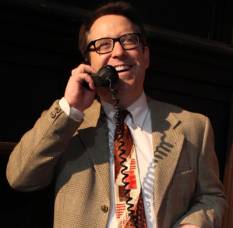
Sierra Madre Playhouse follows last year’s superb, Scenie-winning Incident At Vichy with a beautifully acted, directed, and designed production of Driving Miss Daisy, Alfred Uhry’s award-winning one-acter about an elderly Southern Jewish widow and the African-American driver foisted upon her by her adult son in the years just preceding the Civil Rights Movement.
Though movie fans will surely recall Urhy’s comedy-drama from its 1989 film adaptation starring Jessica Tandy and Morgan Freeman, one which won Miss Tandy the Oscar at the age of 80, “Miss Daisy” made her very first appearance in a tiny off-Broadway theater in 1987, with Dana Ivey and Freeman creating the roles of Miss Daisy and her chauffeur Hoke.
 Under Christian Lebano’s perceptive, nuanced direction, veteran Broadway star Mary Lou Rosato now brings the irascible “Miss” Daisy Werthan to quirky, three-dimensional life in a production sure to back fond memories of the film’s most unforgettable scenes: the fender-bender that brought Hoke into Miss Daisy’s household, Miss Daisy’s initial stubborn insistence on going to the Piggly Wiggly by trolley, her discovery that Hoke has filched a can of salmon from her pantry, Hoke’s refusal to join Miss Daisy at the Martin Luther King dinner because her invitation came too late, and more.
Under Christian Lebano’s perceptive, nuanced direction, veteran Broadway star Mary Lou Rosato now brings the irascible “Miss” Daisy Werthan to quirky, three-dimensional life in a production sure to back fond memories of the film’s most unforgettable scenes: the fender-bender that brought Hoke into Miss Daisy’s household, Miss Daisy’s initial stubborn insistence on going to the Piggly Wiggly by trolley, her discovery that Hoke has filched a can of salmon from her pantry, Hoke’s refusal to join Miss Daisy at the Martin Luther King dinner because her invitation came too late, and more.
As Miss Daisy, Rosato breathes feisty new life into the crotchety old lady you love to hate, or hate to admit that you love. When she crashes her car, she blames it on the vehicle, and when her son gently insists that she herself is at fault, she lashes out, “You’re just saying this to be hateful!” Anyone who’s cursed out a senior citizen driving considerably under the speed limit will chuckle at Miss Daisy’s axiom, “The slower you go, the more you save on gas.” And any driver who’s ever been blamed for getting lost by the map-reader in the back seat will empathize with Hoke when Miss Daisy keeps giving him wrong directions and the two keep getting more and more lost.
 Making the February 1st performance a particular treat was Mitch Ward in the first of three scheduled appearances* as Hoke, and if Ward hasn’t had the benefit of Willie C. Carpenter’s weeks of intensive rehearsal, you’d never know it by his work on the Sierra Madre stage, as touching, as powerful, and as multi-layered a Hoke as one could possibly wish for.
Making the February 1st performance a particular treat was Mitch Ward in the first of three scheduled appearances* as Hoke, and if Ward hasn’t had the benefit of Willie C. Carpenter’s weeks of intensive rehearsal, you’d never know it by his work on the Sierra Madre stage, as touching, as powerful, and as multi-layered a Hoke as one could possibly wish for.
Ward gives us every iota of Hoke’s insight, intelligence, and wit, as when, referring ironically to some stingy Baptists he’s met, “Them’s the people who’s callin’ Jews cheap.” Or when, a propos Miss Daisy’s grudging agreement to let him chauffeur her around, Hoke declares, “Only took six days. Same time it took the Lord to make the world.” Or when he tells his boss a plain and simple, “Miss Daisy, you needs a chauffeur and Lord knows I needs a job. Let’s just leave it at that.” Hoke is a man who has spent little time in school but has learned much about life, people, and self worth.
Uhry, Lebano, Rosato and Ward take us through twenty-five years of Miss Daisy’s and Hoke’s lives, she from age 72 to 97, he from 60 to 85, and the older the two characters get, the richer Uhry’s writing, Lebano’s direction, and Rosato and Ward’s performances become.
 Driving Miss Daisy the movie featured a large cast which included Boolie’s wife Florine, Miss Daisy’s longtime cook Idela, and others who are only referred to in Uhry’s play. Miss Daisy’s long-suffering son is very much present in the stage version, however, and portrayed here by Brad David Reed, absolutely marvelous whether reacting to yet another of his mother’s quirky behaviors or conducting business with Hoke in a way that defies geographic or racial stereotypes.
Driving Miss Daisy the movie featured a large cast which included Boolie’s wife Florine, Miss Daisy’s longtime cook Idela, and others who are only referred to in Uhry’s play. Miss Daisy’s long-suffering son is very much present in the stage version, however, and portrayed here by Brad David Reed, absolutely marvelous whether reacting to yet another of his mother’s quirky behaviors or conducting business with Hoke in a way that defies geographic or racial stereotypes.
It’s hard to imagine a more artistically pleasing scenic design than Gary Wissmann’s, which suggests Miss Daisy’s succession of cars and lets our imagination (aided by Rosato’s and Ward’s finely delineated miming) do the rest. (A final transformation of the car into an entirely different locale is particularly inspired.) Pieces of Miss Daisy’s living room and Boolie’s office move in and out from the wings, all of the above in front of a full moon cut-out that dominates the black upstage wall.
Sammy Ross’s lighting, Kristen Kopp’s lighting, Barry Schwam’s sound design, Cristina Waltz’s wig and makeup design, and most especially Jonathan Beard’s exquisite original music complete a topnotch design package, and one that looks and sounds great on that rarity, an honest-to-goodness proscenium arch stage in a 99-seat house.
In fact, the only irritant at the performance reviewed was the audience’s assumption that every single scene in a play, no matter how short, must be followed by applause, and since there are literally dozens of scenes in Driving Miss Daisy, it soon got to be too much.
Deborah Ross Sullivan is dialect coach, Don Bergmann technical director, Kristin Weber production stage manager, and Andrew Espinosa assistant stage manager.
Spanning a quarter century of 20th Century history, Driving Miss Daisy (like last year’s smash hit movie The Help) puts a human face on the African-American Civil Rights Movement. In the hands of those bringing it to life onstage in Sierra Madre, it not only does that, and superbly so, it warms the heart and touches the soul as well.
*Ward returns as Hoke on February 9 and 17
Sierra Madre Playhouse, 87 W. Sierra Madre Blvd., Sierra Madre.
www.sierramadreplayhouse.org
–Steven Stanley
February 1, 2013
Production stills: Maia Madison


 Since 2007, Steven Stanley's StageSceneLA.com has spotlighted the best in Southern California theater via reviews, interviews, and its annual StageSceneLA Scenies.
Since 2007, Steven Stanley's StageSceneLA.com has spotlighted the best in Southern California theater via reviews, interviews, and its annual StageSceneLA Scenies.







 COPYRIGHT 2024 STEVEN STANLEY :: DESIGN BY
COPYRIGHT 2024 STEVEN STANLEY :: DESIGN BY